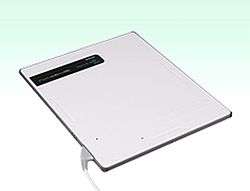Flat panel detector

Flat panel detectors are a class of solid-state x-ray digital radiography devices similar in principle to the image sensors used in digital photography and video.
Principles
X-rays pass through the subject being imaged and strike one of two types of detectors.[1]
Indirect detectors contain a layer of scintillator material, either gadolinium oxysulfide or cesium iodide, which converts the x-rays into light. Due to the impracticability of focusing x-rays, the sensors have exactly the same size as the image they capture. Directly behind the scintillator layer is an amorphous silicon-on glass detector array manufactured using a process very similar to that used to make LCD televisions and computer monitors. Like a TFT-LCD display, millions of roughly 0.2 mm pixels each containing a thin-film transistor form a grid patterned in amorphous silicon on the glass substrate. Unlike an LCD, but similar to a digital camera's image sensor chip, each pixel also contains a photodiode which generates an electrical signal in proportion to the light produced by the portion of scintillator layer in front of the pixel. The signals from the photodiodes are amplified and encoded by additional electronics positioned at the edges or behind the sensor array in order to produce an accurate and sensitive digital representation of the x-ray image.
Direct FPDs Amorphous selenium (a-Se) FPDs are known as “direct” detectors because X-ray photons are converted directly into charge. The outer layer of the flat panel in this design is typically a high-voltage bias electrode. X-ray photons create electron-hole pairs in a-Se, and the transit of these electrons and holes depends on the potential of the bias voltage charge. The charge pattern is then read by a TFT array in the same way images produced by indirect detectors are read.
Advantages

Flat-panel detectors are more sensitive and faster than film. Their sensitivity allows a lower dose of radiation for a given picture quality than film. They are lighter, far more durable, smaller in volume, more accurate, and have much less image distortion than image intensification detectors and can also be produced in larger sizes.
External links
References
- ↑ Goel, Ayush. "Flat panel detectors". Radiopaedia.org. Retrieved 12 September 2014.